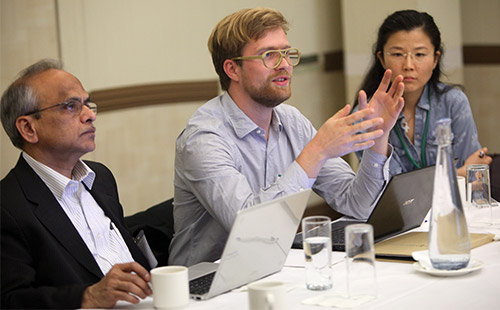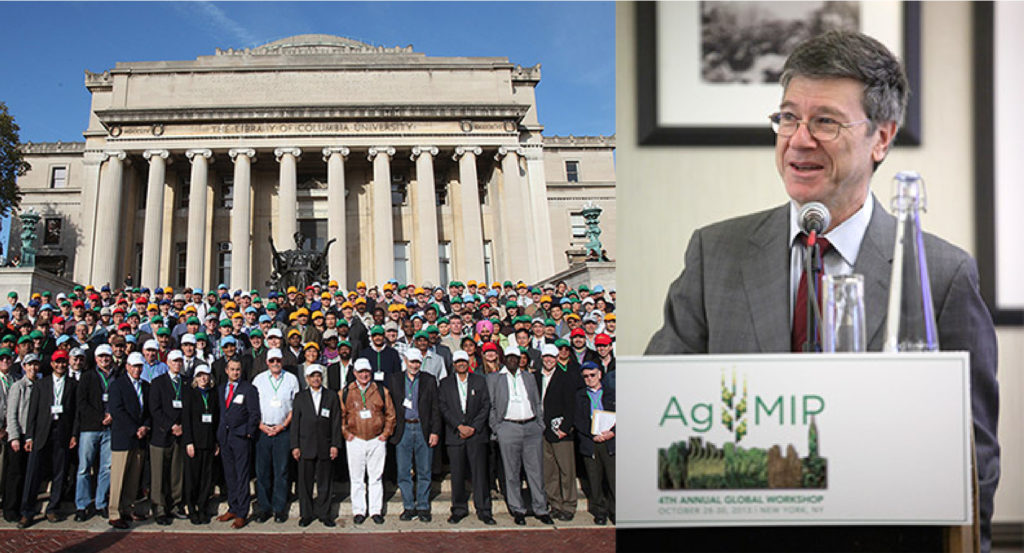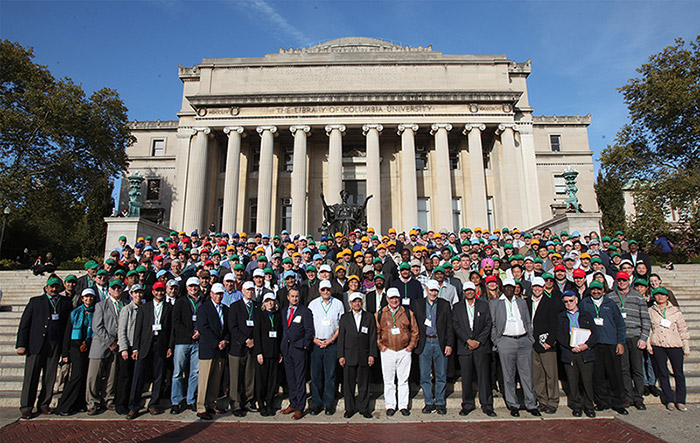Agenda, Participant List, Poster Abstracts, Workshop Report
Presentations, Work Group Reports, Poster PDFs
As the fine autumn weather continued in late October in New York City, the Agricultural Model Intercomparison and Improvement Project (AgMIP) convened its annual Global Workshop – the fourth such event since the US Department of Agriculture founded AgMIP in 2010. Members of the AgMIP community convened at Columbia University’s Faculty House where Jeffrey Sachs, Director of the Earth Institute, AgMIP Steering Group Co-Chairs Mannava Sivakumar and Martin Parry, and AgMIP Principal Investigators Cynthia Rosenzweig, James Jones, Jerry Hatfield, and John Antle kicked off the 3-day workshop.
The workshop brought together over 240 participants from 130 institutions representing the diversity of the AgMIP community. In addition to AgMIP core disciplines of climate, crop, and economic modeling and information technology, initiatives exploring water, soil and crop rotation, aggregation and scaling, pests and diseases, livestock and grasslands, uncertainty, ozone, and climate variability and extremes were also represented. The workshop focused on critical improvements for next-generation models, data, and decision support systems for agricultural assessments of climate change impact and adaptation, and for sustainable intensification of agriculture. Participants also advanced strategies for coordinated regional and global assessments of food security.
Workshop participants in front of Low Library, Columbia University.
“You have convened at a crucial time.” Jeffrey Sachs said to the workshop participants, “Governments are going to need agricultural strategies and technological roadmaps. What new crop types, varieties, farm systems need to be put in place to resist climate change, create resilience, increase water efficiency, reduce heat stress, and so forth? I don’t think these roadmaps exist right now.”
A Speed Science session followed the introductions, in which 22 scientists shared key findings, recent accomplishments, and plans for the future. The presentations were divided into seven broad categories: Crop Model Intercomparisons and Improvement, Global Assessments, Regional Integrated Assessments, Cross-Cutting Themes, Key Interactions, New Approaches for Climate-Crop Assessment, and Data and Information Technology.
The first day was capped by an evening poster session and reception held at Columbia University’s Low Library with support by The Earth Institute. G. Michael Purdy, Executive Vice-President for Research at Columbia, encouraged participants to mix and view the 65 posters displaying diverse topics such as Integrated Regional Assessments in Sub-Saharan Africa, South Asia, East Asia and Latin America, Economics, Climate, Pests and Diseases, Extreme Events, Water, Evapotranspiration, Ozone, Soil and Crop Rotation, Adaptation, Data and IT, and crop specific topics such as wheat, rice, maize, soybean and potato.

Poster session at Low Library, Columbia University.
“This is a great opportunity for exchange and learning in true interdisciplinary science to inform a very important problem –food security for a diverse and growing global population,” said G. Michael Purdy. “Columbia University is proud to host the coordinating office of AgMIP, and is very grateful to UKaid for its major support of this endeavor, to which USDA, CCAFS, USAID, and numerous collaborating partners contribute to enable the AgMIP community to deliver robust and policy-relevant research outputs.” PDFs of the posters and abstracts are available here for download.
In addition to breakouts focusing on model integration and scales, the second day of the workshop included a speed session highlighting complimentary global and regional programs CCAFS, MACSUR, USDA CAPs, Yield Gap Atlas, CIMSANS, FAO, and MODEXTREME.
 Discussion during breakout session.
Discussion during breakout session.
At the completion of the third day breakout groups reconvened in plenary to present report backs from their sessions. PDFs of the reports as well as presentations from the workshop are available here.
Many of the groups made plans to meet again and collaborate on research and publications. Some groups like Pests and Diseases will be new to AgMIP while others will continue to build on work initiated previously. All will try to incorporate their findings into integrated assessments of food security on both the regional and global scale. It is these assessments, which combine information from crop, climate and economic models that will feed the next generation of decision support tools for policymakers in the coming decades.
Martin Parry, Co-Chair of the AgMIP Steering Committee remarked of the workshop, “What’s obvious about this project is it’s tapped into a huge latent demand…and that’s why it has picked up speed so quickly.” He continued, “90-95% of the effort this week has been on improving the science. But you have also heard a call for messages, from donors and policymakers, and it can be complimentary. As one drives forward in model intercomparision and improvement, instead of a parallel path, have questions embedded in single pathway. How would the outcome from your model be altered with mitigation and adaptation?”
This is one of the questions AgMIP scientists will continue to pursue as the energy from this intensive workshop propels the teams forward into the coming year.

Left: Workshop participants raise their hats in the fine fall weather in New York. Right: Jeffrey Sachs addresses the opening plenary session of the 4th Annual AgMIP Global Workshop.

